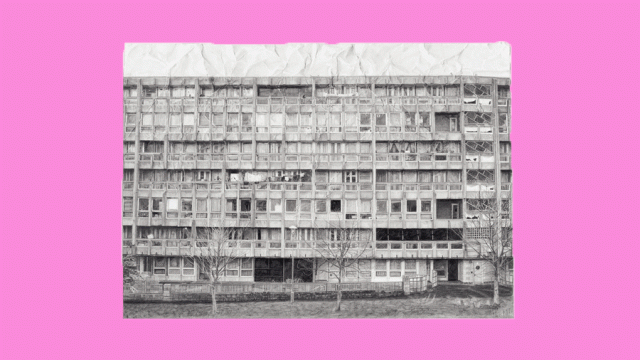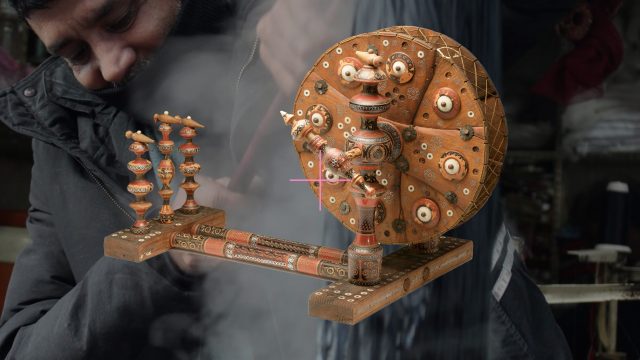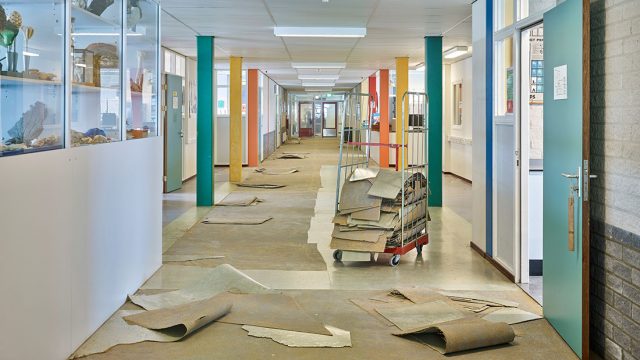This year’s Venice Art Biennale was curated by Cecilia Alemani, the first Italian woman curator in the Biennale’s 127-year history. The Director and curator of the High Line Art programme in New York chose as her theme The Milk of Dreams, a title taken from an illustrated fairytale by surrealist artist Leonora Carrington (1917 – 2011) that depicts a world in constant metamorphosis. Of the 213 artists Alemani selected from 58 countries, her edition is pioneering in that only 10% of participants are male, a reversal of the norm: it has been called ‘the women’s biennale’. Over its seven-month run, about 700,000 visitors are expected at the event, the largest and most prominent art exhibition in the world.

Alemani chose Qatari-American artist and author Sophia Al-Maria to create the V&A and la Biennale di Venezia’s Special Project in the Pavilion of Applied Arts. This is our sixth collaboration with la Biennale and we are the only museum to be represented alongside national pavilions in this way. Alemani encouraged Al-Maria to take inspiration from the V&A’s large collection of automata, and to explore the intersection between the body and technology in a video work. Leonora Carrington, she noted, liked to claim that her birth had resulted from an encounter between her mother and a machine.
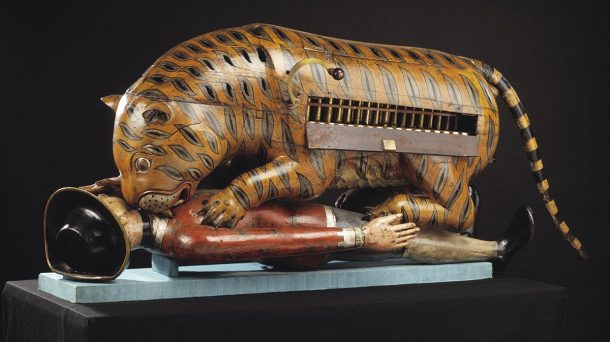
Al-Maria was fascinated by Tipu’s Tiger, which depicts a prostrate European man being mauled by a ferocious beast. The almost life-size automaton, on view in our South Asia Gallery, was made in the 1790s for Tipu Sultan, the Muslim ruler of the Kingdom of Mysore in India. After he was killed in the Siege of Seringapatam by British forces, the automaton was shipped to London where it was a popular exhibit in the East India Company Repository and was later transferred to the V&A. The tiger’s flank contains an organ, one of whose pipes emerges from the soldier’s mouth to voice his screams.
For Al-Maria, the ‘man-tyger-organ’, as it was described in the Repository, shows a fantasy of revenge against colonial oppressors and also has an erotic dimension in its suggestive coupling of man and beast/machine. In her film installation, Tiger Strike Red, this object of resistance, and then Imperial booty, stalks the library and galleries of the V&A as a shapeshifting spirit, with a voiceover that reflects on themes of colonial violence and racism, and how these prejudices continue to haunt our current technologies and the inherent bias of the algorithms that are reshaping out world.
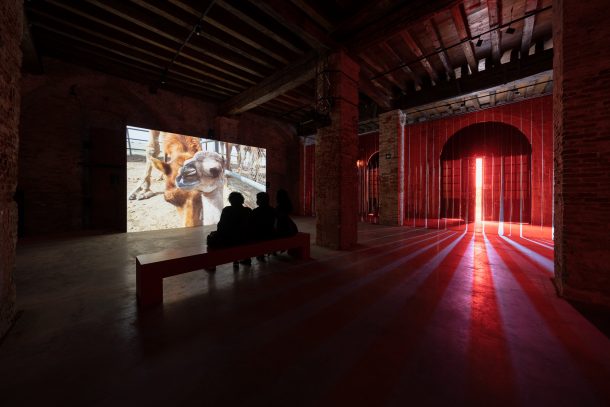
Shot at the V&A with an all-female cast and crew, and on location in the Qatari desert, Tiger Strike Red will be screened at the museum at a special event later in the year. The film features a weapons performance by Ayesha Hussein using an Indian sword which she wields in a choreographed dance around the museum, as well as historic footage of Ram Gopal, ‘the Nijinsky of India’, performing Indian classical dance at the V&A in 1947. An electronic soundtrack was composed from audio recordings of the automaton performing God Save the Queen and La Marseillaise by the Senegalese-born Kuwaiti composer Fatima Al Qadiri.
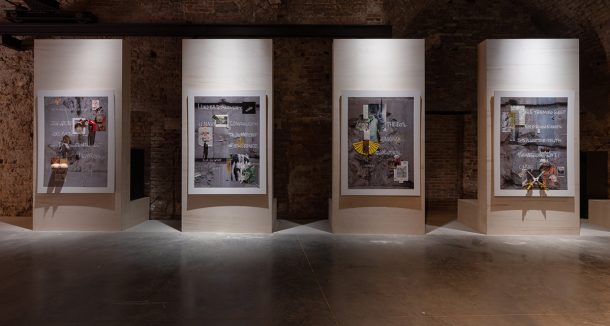
Also included in the exhibition are seven new collage works hung on top of large panels in the gallery space that leads into the film, which are wallpapered with enlarged photos of the Blitz damage seen on the V&A’s exterior walls. Al-Maria describes the objects and images that she’s included – many of which also appear as props in her film – as shrapnel embedded in the building, and they function as a sort of index, or footnotes, to the film. Her installation interrogates the institution’s colonial past, and the Imperial origins of some of its collections, and seeks to decentre and rewrite that history.
Among the national entries, the US and UK pavilions are represented by female artists of colour for the first time, who also explore themes of race, power and representation: both won golden lions for their work. Simone Leigh covered the exterior of the US pavilion with a thatched façade, intended to parody the model African villages from the 1931 Paris Colonial exhibition; and, in Feeling Her Way, Sonia Boyce filled the British Pavilion with emotive singing improvised by five Black female musicians spanning multiple generations and musical styles.

The Russia Pavilion stood empty after the curators and artists resigned in protest at the invasion of Ukraine. Not far away is Piazza Ucraina, an outside space designed by the Kiev-based architect and artist Dana Kosmina, with 1000 white sandbags piled in a cone at its centre as if to protect a hidden statue from war damage. President Zelensky spoke via video link at the opening of the This is Ukraine: Defending Freedom exhibition at the Scuola Grande della Misericordia: ‘There are no tyrannies that would not try to limit art because they can see the power of art,’ he said. ‘Art can tell the world things that cannot be shared otherwise.’
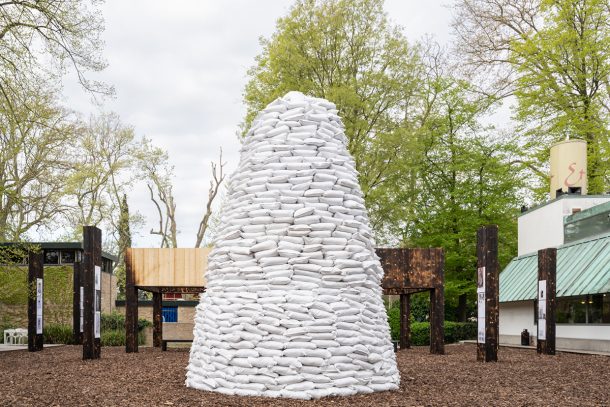
Alemani’s central exhibition was unusual in that it also included historic work in five ‘time capsules’: museum moments that foreground the women too-often overlooked in the history of Surrealism, Dada and the Bauhaus. While her Biennale seeks to ‘re-center’ women in the story of art, the ageing lions of the artworld were forced to take up artistic residence in other landmarks in the city: Anselm Kiefer in the Doge’s Palace, Anish Kapoor at the Accademia and Palazzo Manfredi (recently acquired by his Foundation); Marc Quinn at the Museo Archeologica Nazionale; and Anthony Gormley at Carlo Scarpa’s Olivetti Showroom. As you walk around the city, it is hard not to notice the huge billboards that somewhat over-emphatically assert their presence.
Tiger Strike Red, the V&A’s contribution to the 59th Venice Art Biennale, is on view at The Pavilion of Applied Arts in the Arsenale until 27 November.
